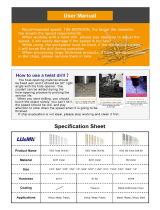materials and the lower end for harder materials.
Set the drill rotating speed to the recommended
speed.
2. Position the workpiece or tool so that the center
pin is directly over the desired drilling location.
3. The use of HAWG WASH™ cutting fl uid is re-
quired for long life of these cutters (see "Lubrica-
tion"). Attach the hose to the oil fi tting on the side
of the arbor and to your lubricant reservoir.
4. Swing the arbor arm in the direction of the spindle
rotation until it comes in contact with the side of
the drill motor or drill press.
5. Start the drill motor.
6. Cutting fl uid will not fl ow freely until the cen-
ter pin is depressed slightly. Move the cutter
towards the material until the center pin is de-
pressed slightly and begin pumping cutting fl uid.
7. When feeding the cutter into the material, use
only enough pressure to produce effi cient cutting
without overloading the tool or cutter. Because
STEEL HAWG™ CUTTERS have multiple
cutting edges, they require considerably less
downward pressure than ordinary twist drills.
STEEL HAWG™ CUTTERS work best at their
recommended drill rotating speed and with mod-
erate pressure. Excessive pressure will only slow
the operation and damage the cutter. Use less
feed pressure when slotting or notching because
there is less support for the cutting edges in these
situations.
8. Avoid raising the cutter before the cut is com-
plete. Keep constant pressure throughout the
entire operation to prevent chips and cuttings
from falling under the cutting edges. A loose
cutting under the cutter can make cutting diffi cult
or impossible.
9. When the cut is completed, stop pumping cutting
fl uid, and withdraw the cutter while the drill motor
is still rotating.
10. Turn the drill motor off.
11. When the drill has stopped, use a pliers to re-
move cuttings from the bit and arbor. Use care
to avoid damaging the carbide teeth.
12. The center pin is spring loaded and should
eject the slug when the cut is completed. Pro-
vide protection from falling slugs for people or
property below.
Lubrication
A continuous flow of lubricant is required with
these cutters. MILWAUKEE HAWG WASH™ (cut-
ting fl uid) is recommended for most applications.
It is available in a case of twelve 16 oz. bottles of
concentrate, Cat. No. 49-32-0081, which will make
1 gal. of lubricant per bottle. Failure to use the
lubricant properly will cause cutter damage. When
cutting with STEEL HAWG™ CUTTERS, supply a
continuous fl ow of cutting fl uid to the arbor. When
notching or slotting, the lubricant system may not
supply enough lubricant to the cutting area. In
these situations, the cutting fl uid should be applied
directly to the area being cut. Alternative lubricants
introduce different cooling and lubricating reactions.
The operator is responsible for the application of
lubricants other than HAWG WASH™ cutting fl uid.
ACCESSORIES
WARNING To reduce the risk of injury,
always unplug the tool before attaching
or removing accessories. Use only specifi cally
recommended accessories. Others may be
hazardous.
Maintaining Tools
Keep your tool in good repair by adopting a regular
maintenance program. Before use, examine the
general condition of your tool. Inspect guards,
switches, tool cord set and extension cord for
damage. Check for loose screws, misalignment,
binding of moving parts, improper mounting, bro-
ken parts and any other condition that may affect
its safe operation. If abnormal noise or vibration
occurs, turn the tool off immediately and have the
problem corrected before further use. Do not use a
damaged tool. Tag damaged tools “DO NOT USE”
until repaired (see “Repairs”).
Under normal conditions, relubrication is not neces-
sary until the motor brushes need to be replaced.
After six months to one year, depending on use,
return your tool to the nearest MILWAUKEE service
facility for the following:
• Lubrication
• Brush inspection and replacement
• Mechanical inspection and cleaning (gears, spin-
dles, bearings, housing, etc.)
• Electrical inspection (switch, cord, armature, etc.)
• Testing to assure proper mechanical and electrical
operation
WARNING To reduce the risk of injury,
electric shock and damage to the tool,
never immerse your tool in liquid or allow a
liquid to fl ow inside the tool.
MAINTENANCE
WARNING To reduce the risk of injury,
always unplug your tool before performing
any maintenance. Never disassemble the tool
or try to do any rewiring on the tool’s electrical
system. Contact a MILWAUKEE service facility
for ALL repairs.
Cleaning
Clean dust and debris from vents. Keep the tool
handles clean, dry and free of oil or grease. Use
only mild soap and a damp cloth to clean your
tool since certain cleaning agents and solvents
are harmful to plastics and other insulated parts.
Some of these include: gasoline, turpentine, lacquer
thinner, paint thinner, chlorinated cleaning solvents,
ammonia and household detergents containing
ammonia. Never use fl ammable or combustible
solvents around tools.
Repairs
If your tool is damaged, return the entire tool to the
nearest service center.
Rely only on high-grade power tools on our virtual shelves.












